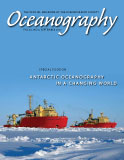Article Abstract
Much of what is known about the evolution of Antarctica’s cryosphere in the geologic past is derived from ice-distal deep-sea sedimentary records. Recent advances in drilling technology and climate proxy methods have made it possible to retrieve and interpret high-quality ice-proximal sedimentary sequences from Antarctica’s margins and the Southern Ocean. These records contain a wealth of information about the individual histories of the East and West Antarctic Ice Sheets and associated temperature change in the circum-Antarctic seas. Emerging studies of Antarctic drill cores provide evidence of dynamic climate variability on both short and long timescales over the past 20 million years. This geologic information is critical for testing and improving computer model simulations used to predict future environmental change in the polar regions. Identifying the mechanistic links between past Antarctic ice-volume fluctuations and oceanographic change is necessary for understanding Earth’s long-term climate evolution. While recent successes highlight the value of ice-proximal records, additional scientific drilling and climate proxy development are required to improve current knowledge of Antarctica’s complex paleoenvironmental history.

